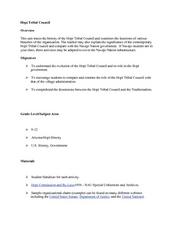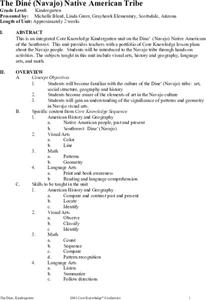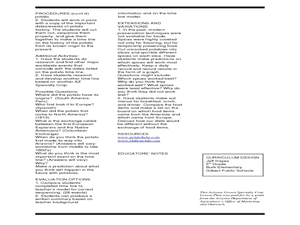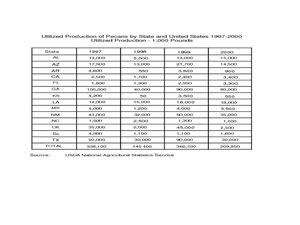Curated OER
Hopi Tribal Council
Focusing on the differences between traditional Hopi government and the Hopi Tribal Council, this resource is a good addition to your unit on Native American culture. Learners conduct Internet research, analyze primary source photos, and...
Curated OER
Native Americans in Utah History: Research Project
Students research the basic cultural information available on the various Native American cultures of Utah. They investigate the historical time period, shelters, weapons, tools, foods and methods of obtaining food.
Curated OER
The Power of Maps & Native American Cultures
Sixth graders discover where and how five Native American cultures lived in North America in what is currently the United States. They examine their way of life and the regions they inhabited. Additionally, 6th graders will understand...
Smithsonian Institution
Mexican War
Did you know that without the Mexican War, the United States would not include the states of Arizona, California, New Mexico, Texas, Nevada, Utah, and even parts of Colorado? Scholars learn a variety of interesting facts about the...
Curated OER
Navajo Pottery: Beautiful Objects
Young potters make their very own version of the classic Navajo Pottery. With helpful worksheets and applicable cross-curricular activities, the lesson is an enriching way to mold both your clay and the multicultural acceptance of your...
Curated OER
The Díne (Navajo) Native American Tribe
Students participate in a variety of activities to become familiar with the Navajo Indians. In this Díne (Navajo) Native American tribe lesson, students understand where the Navajo tribe lived and find them on a map. Students discuss the...
Curated OER
Forced to Move in More Ways Than One
Eleventh graders explore the Native American movement. They study the Indian Removal Act of 1830, the Dawes Act of 1887, and the Indian Boarding Schools in 1887. They research each episode and create a Venn diagram poster.
Curated OER
Arizona!! How the Heck Did I End Up Here???
Students research the historical background of the potato. In this potato research lesson, students cut out the important dates in potato history. Students make a timeline for the events.
Curated OER
Utah: State History
In this Utah state history learning exercise, students read two and a half pages of information about Utah and complete 10 true and false questions.
Curated OER
This Land is My Land, That Land is Your Land!
Students explore the Native American migrant experience in the United States. They define and describe reservation and the relationship between the U.S. Government and Native tribes through individual textbook research and class discussion.
Curated OER
Changing Opinions
Students compare their preconceptions of Native American movement with their current perceptions. They identify why they have changed. Students conclude with a final reflection addressing how they define the Native American experience in...
Curated OER
Historical Summaries: Arizona
In this Arizona history worksheet, students read a 2-page article about prehistoric, Spanish, Mexican, and American Arizona prior to responding to 2 short answer questions.
Curated OER
Exploring the Plant History of Canyon de Chelly
Pupils research native and conventional plants in Canyon de Chelly and surrounding area. Students collect, draw, and write about a variety of plants through research. In the descriptive writings, pupils include a brief history of plant...
Curated OER
Create a City: An Urban Planning Exercise
Students explore the effects of population growth in Arizona. In this history lesson, students work in small groups to create a "perfect" city. Activities include examining the Arizona census results then discussing the importance of...
Curated OER
Native Species Restoration and its Impact on Local Populations
Students explore how predators help control the growth of prey species for a more balanced ecosystem.
Curated OER
A Year in Arizona
Fourth graders create a calendar about their state. For this state calendar lesson, 4th graders select a state theme and create a calendar based on that theme. Students write paragraphs for each month related to the theme and design the...
Curated OER
The Four Corners Region of the United States Cultures, Ruins and Landmarks
Students who live in the inner city are introduced to the four corners region of the United States. In groups, they examine how the region differs compared to where they live and their culture. They develop maps of the area and locate...
Curated OER
Pecan Power
Students study the origins of pecans and complete a bar graph from the data they have discovered. In this pecan lesson plan, students draw pecans, discuss a pecan time line, and draw a bar graph comparing Arizona pecans to other states.
Curated OER
Native Species Restoration and its Impact on Local Populations
Students watch video clips of ecosystems and answer questions relating to them.
Curated OER
Fertilizers, Pesticides and Human Health- American Lessons
Students explore migration and why people move. They explore the movement of native populations. Students explore the economy as an factor in migration. They discuss the exploitation of the migrant worker.
Curated OER
New Mexico
In this New Mexico learning exercise, students read a two page text about the history of the state of New Mexico. Students answer ten true and false questions.
Curated OER
Non Native Species: English Ivy-Landscape Plant or Deadly Killer?
High schoolers study the impact that invasive species have on biodiversity and more natural areas.
Curated OER
The Gilded Age & the Progressive Era (1877–1917)
In this online interactive philosophy worksheet, learners respond to 7 short answer and essay questions about the Gilded Age and Progressive Era in the United States. Students may check some of their answers on the interactive worksheet.
Curated OER
Non Native Species: English Ivy-Landscape Plant or Deadly Killer?
Students examine an area overrun by English Ivy. They explore how invasive species affect an ecosystem. They also study about the lack of biodiversity and how to measure it out in the field.

























